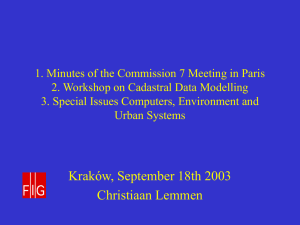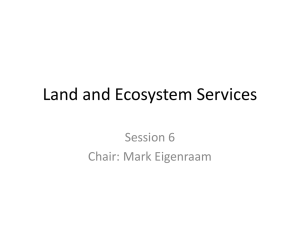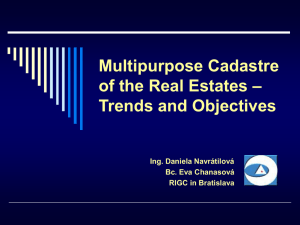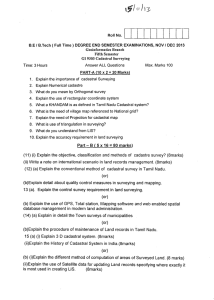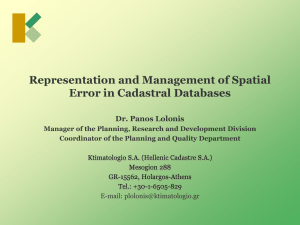A New Multi-Dimensional Information System Introduced in Sweden
advertisement
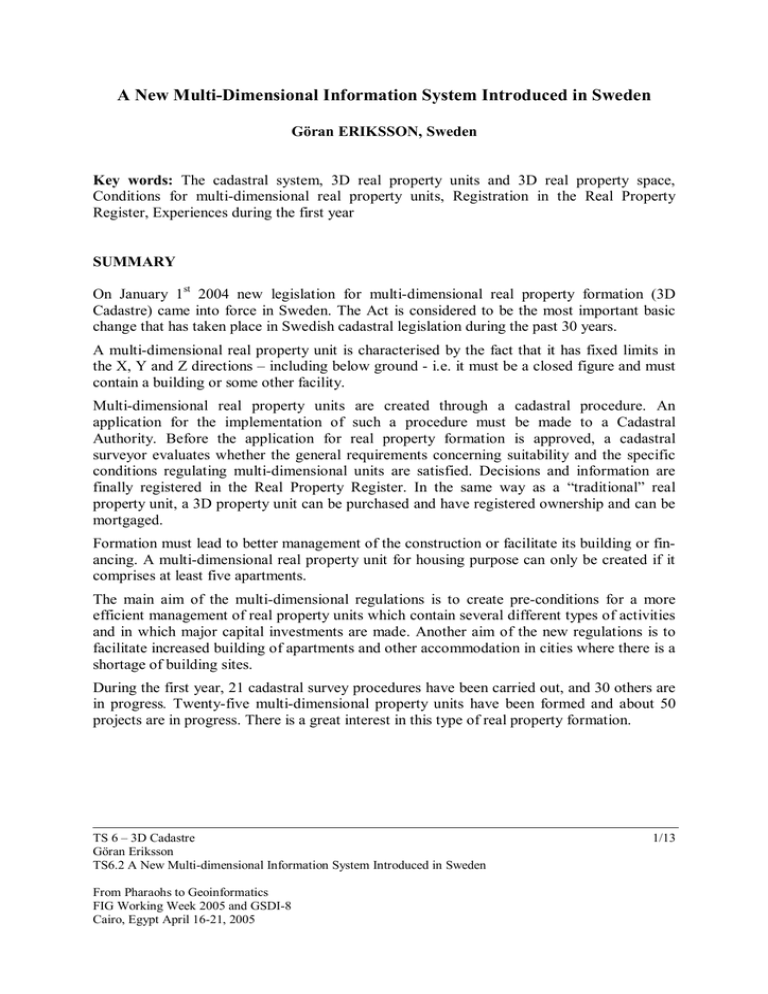
A New Multi-Dimensional Information System Introduced in Sweden Göran ERIKSSON, Sweden Key words: The cadastral system, 3D real property units and 3D real property space, Conditions for multi-dimensional real property units, Registration in the Real Property Register, Experiences during the first year SUMMARY On January 1st 2004 new legislation for multi-dimensional real property formation (3D Cadastre) came into force in Sweden. The Act is considered to be the most important basic change that has taken place in Swedish cadastral legislation during the past 30 years. A multi-dimensional real property unit is characterised by the fact that it has fixed limits in the X, Y and Z directions – including below ground - i.e. it must be a closed figure and must contain a building or some other facility. Multi-dimensional real property units are created through a cadastral procedure. An application for the implementation of such a procedure must be made to a Cadastral Authority. Before the application for real property formation is approved, a cadastral surveyor evaluates whether the general requirements concerning suitability and the specific conditions regulating multi-dimensional units are satisfied. Decisions and information are finally registered in the Real Property Register. In the same way as a “traditional” real property unit, a 3D property unit can be purchased and have registered ownership and can be mortgaged. Formation must lead to better management of the construction or facilitate its building or financing. A multi-dimensional real property unit for housing purpose can only be created if it comprises at least five apartments. The main aim of the multi-dimensional regulations is to create pre-conditions for a more efficient management of real property units which contain several different types of activities and in which major capital investments are made. Another aim of the new regulations is to facilitate increased building of apartments and other accommodation in cities where there is a shortage of building sites. During the first year, 21 cadastral survey procedures have been carried out, and 30 others are in progress. Twenty-five multi-dimensional property units have been formed and about 50 projects are in progress. There is a great interest in this type of real property formation. TS 6 – 3D Cadastre Göran Eriksson TS6.2 A New Multi-dimensional Information System Introduced in Sweden From Pharaohs to Geoinformatics FIG Working Week 2005 and GSDI-8 Cairo, Egypt April 16-21, 2005 1/13 SUMMARY IN SWEDISH Den 1 januari 2004 trädde nya lagregler om tredimensionell fastighetsindelning (3D) i kraft i Sverige. Lagändringen betecknas som den största principiella förändringen inom den svenska fastighetsrätten på 30 år. En tredimensionell fastighet karakteriseras av att den ska ha fastställda gränser såväl i sidled, höjdled som djupled, dvs. den ska utgöra en sluten volym och den ska inrymma en byggnad eller annan anläggning. Tredimensionella fastigheter bildas vid lantmäteriförrättning. Besluten redovisas i fastighetsregistret. I registret anges vilken typ av byggnad som 3D-fastigheten inrymmer och var den är belägen i plan och höjd. Vissa särskilda villkor måste vara uppfyllda för att 3D-fastigheter ska kunna bildas. Åtgärden måste leda till en bättre förvaltning av anläggningen eller underlätta dess uppförande eller finansiering. En 3D-fastighet för bostadsändamål kan endast bildas om den inrymmer minst fem bostadslägenheter. Ett syfte med 3D-reglerna är att skapa förutsättningar för en effektivare fastighetsförvaltning för större, kapitalkrävande anläggningar med flera olika verksamhetsutövare. Ett annat syfte med de nya reglerna är att skapa förutsättningar för ökat bostadsbyggande i tätorter där det råder brist på tomtmark genom att underlätta tillbyggnader ovanpå befintliga byggnader. Under det första året har 21 lantmäteriförrättningar genomförts och ett 30-tal ärenden är under handläggning. 25 3D-fastigheter har bildats och cirka 50 projekt är på gång. Intresset är mycket stort och många förfrågningar görs till lantmäterimyndigheterna. Figure 1: Multi-dimensional real property unit for dwellings (1:5), office (1:4) and commercial purposes (1:3). TS 6 – 3D Cadastre Göran Eriksson TS6.2 A New Multi-dimensional Information System Introduced in Sweden From Pharaohs to Geoinformatics FIG Working Week 2005 and GSDI-8 Cairo, Egypt April 16-21, 2005 2/13 A New Multi-Dimensional Information System Introduced in Sweden Göran ERIKSSON, Sweden 1. INTRODUCTION To facilitate an understanding of the background to the new legislation for multi-dimensional information system, an overview description will first be given of the Swedish cadastral system and its connection with division into property units, as well as of the cadastral procedure for creating and changing real property units. An account will also be given of certain rights in land and of the interaction between property subdivision and political control of land use. 1.1 The Swedish Cadastral System The first cadastral system in Sweden was created in the 17th century. The purpose was to establish a base for real property taxation. In 1628 Lantmäteriet (the National Land Survey of Sweden) was established. All land in Sweden and, in principle, also all water areas, are divided into property units or joint property units. This means that there is a comprehensive division into property units entered in the Swedish Real Property Register. There are no unregistered public areas. The only areas not included in property subdivision are those comprising public water areas, which are in the sea and in four of Sweden’s largest lakes. The Swedish cadastral system consists of the Land Law, the Real Property Formation Act, the Utility Easements Act, the Joint Facilities Act, the Land Survey Code and the Real Property Register, which includes the Land Register. The Swedish cadastral system is considered to be a well-functioning, straightforward, efficient and secure system for all concerned parties. 1.2 The Land Law and The Real Property Formation Act The formation and re-formation of property units in Sweden can only be carried out through an official decision. Changes to property division are normally made through a cadastral procedure under the Real Property Formation Act. This is the responsibility of the public cadastral authorities. There are both national and municipal authorities of this kind and the national responsibility is vested in Lantmäteriet. The current Land Law and Real Property Formation Act were introduced in 1972; the legal structure is, however, still modern and logical. Together with the Planning and Building Act (1987) and the Environmental Act (1999), the government has also created a number of other valuable instruments for implementing its land policies. TS 6 – 3D Cadastre Göran Eriksson TS6.2 A New Multi-dimensional Information System Introduced in Sweden From Pharaohs to Geoinformatics FIG Working Week 2005 and GSDI-8 Cairo, Egypt April 16-21, 2005 3/13 The Real Property Formation Act covers subdivision, reallotment, amalgamation, reestablishment of property boundaries, registration etc. The law is applied in both urban and rural areas and is a powerful tool that authorises the cadastral surveyor to make decisions concerning changes in the division of land, even those that are not voluntary. The view taken in Sweden is that the division of land into property units shall reflect the current use of the land. Thus property units cannot be freely formed, and this is reflected in the provisions of the Property Formation Act, which require property units to be deemed suitable for their intended use and sustainable on a long-term basis. When a property unit is formed for housing purposes, for the construction of a dwelling house to be approved there must be access to a road, it must be possible for the building to be supplied with water and sewerage services and so on. Similarly, it is not normally possible for a new housing property to be formed next to an environmentally disruptive facility. Further, it is stipulated that property units may not be formed at variance with existing plans or other land-regulatory provisions. For example, shoreline areas in Sweden are under general protection, so as to make them accessible for the general public. Property units may not be formed in these areas if this would thwart the purpose of the provisions. The regulations for land policy sometimes also preclude partial transfers of property units. The law includes compulsory purchase and, therefore, the cadastral survey process is frequently used in infrastructure projects instead of time-consuming expropriation processes. Sweden is one of the countries that use a system of fixed boundaries. A cardinal principle in this system is that all boundaries shall be clearly defined: a boundary resulting from property formation shall be demarcated on the ground to the extent that is considered necessary. New boundaries are determined with a acceptably high standard of accuracy. Normally they are demarcated on the ground at the time of their establishment, but older boundaries that were created through an agreement between the landowners themselves, in the days when this was permitted, still exist. The importance of boundary demarcation is reflected by it being a punishable offence to remove or alter the position of a boundary beacon or to set out what can be taken to be a boundary beacon. 1.3 The Cadastral Process The activities of the cadastral authorities are regulated - as mentioned earlier - by the legislation in the Real Property Formation Act, the Utility Easements Act and the Facilities Act. A cadastral surveyor carries out cadastral procedures. A cadastral procedure differs from a judicial procedure in that the cadastral surveyor, independently, has the task of investigating and taking decisions concerning the suitability of the measures to be taken. This includes carrying out investigation, contacts with landowners and liaison with relevant public authorities. The latter is required in order to obtain supportive documentation for assessing the compatibility of the intended measures with planning requirements for the area concerned. Within the framework of a cadastral procedure the cadastral surveyor can engage other outside experts, for example to compile background material for complicated compensation decisions or to plan infrastructure such as roads. TS 6 – 3D Cadastre Göran Eriksson TS6.2 A New Multi-dimensional Information System Introduced in Sweden From Pharaohs to Geoinformatics FIG Working Week 2005 and GSDI-8 Cairo, Egypt April 16-21, 2005 4/13 Regulations concerning the formation and re-formation of property units are contained in the Real Property Formation Act. There are three distinct procedures for the formation of new property units: subdivision, partition and amalgamation. There is only one re-formation procedure, namely reallotment. Reallotment, however, can embrace several different changes. Land can be transferred from one property unit to another, which can involve major reallocation or the relocation of boundaries between property units. Reallotment can also be used as a means for forming joint property units and amending participation in them. It is also a means for forming, amending and cancelling easements. In addition, the Property Formation Act contains provisions regarding property definition whereby the extent of a property unit can be determined, for example as regards the correct alignment of a boundary or the existence of an easement. Cadastral procedure can be used for taking certain coercive decisions, such as procurement of land for streets within areas subject to a detailed development plan or for giving one property unit the right to construct a road across another unit against the wishes of the owner of the servant property. Property formation procedures are documented in cadastral documents, which normally comprise minutes together with a description of the property formation and a cadastral map. When a cadastral procedure has gained force of law, an entry to this effect must be made in the Real Property Register. A cadastral procedure is deemed to be complete when this entry has been made. A cadastral survey starts with an application for a survey to be carried out. Normally, the survey will involve only a few persons but, in some cases, as many as several hundred persons may be involved. The process consists of following components: − Application − Investigation − Meeting (negotiation) − Field survey, measuring/demarcating boundaries − Decisions (juridical, economic and technical) − Registration It is often necessary for the cadastral surveyor to carry out his/her own investigations. During meetings with the parties (the applicants, neighbours and others), the surveyor will encourage those present to become involved in the process with the aim of reaching a decision which can be accepted by all parties. Participation in meetings is not compulsory in "easy" cases. All decisions must be based on the law, land policies and regulations and taken in consultation with the local authority, the County Administration Board and different sector agencies such as the National Road Administration. If, when all concerned parties have been heard, the investigation shows that it is possible to carry out the survey, the surveyor can take decision concerning both the new subdivision of land and other questions such as easements, economic matters, new boundaries etc. The surveyor is also responsible for securing the interests of creditors where there are mortgages. TS 6 – 3D Cadastre Göran Eriksson TS6.2 A New Multi-dimensional Information System Introduced in Sweden From Pharaohs to Geoinformatics FIG Working Week 2005 and GSDI-8 Cairo, Egypt April 16-21, 2005 5/13 The surveyor must be totally impartial and independent and his/her decisions must be fair and take into consideration the needs of both society and the concerned parties. In addition to being responsible for implementation, the surveyor is also responsible for preparing a budget for the procedures. If any of the parties is dissatisfied with the Cadastral Authority's decision, an appeal must be lodged within four weeks. 1.4 Development of Legislation During the past few years Lantmäteriet has actively participated in the development of cadastral legislation. New requirements and demands have resulted in, amongst others, two important changes in the legislation: 1.4.1 Transmission and detachment of fixtures An important principle in Swedish cadastral legislation is that a property unit, in addition to land, also comprises certain objects that are connected to it, so called fixtures, such as buildings or other facilities, utilities, trees and similar. Buildings and facilities which have been built outside the property, based on servitudes or through utility easements, are also fixtures. Since January 1st 2002 it is legally possible to transmit buildings and other facilities that belong to a property to another property without the need to physically move them. A prerequisite is that there is an official easement or that an easement can be created through a cadastral procedure. It is also possible to detach utilities that belong to a property in order that they, thereafter, shall constitute personal property. A requirement is that there is a utility easement or that an easement can be created. The transmission or detachment of property fixtures can only be carried out through a cadastral procedure. The new regulations will certainly result in an increased use of and confidence in cadastral procedures. 1.4.2 Mortgage-free subdivision Prior to July 1st 2004, subdivision did not lead to any changes to the object for the lien. Following subdivision, a mortgage that had been registered in the property which had been the subject of the subdivision encumbered the same land area as prior to the subdivision. Responsibility for the mortgage was shared between the residual property unit and the subdivided parcel. The joint responsibility for the mortgage that arose in this way was seldom permanent. This was a situation that normally was undesirable. A separate process, called relaxation, which was carried out by the Land Registration Authority, was required to free the subdivided parcel from the residual property's mortgages. Since July 1st 2004 changes have been made to the legislation, which now make it possible for a cadastral surveyor to formally rule, within the framework of a cadastral procedure, that a subdivided parcel shall not be encumbered by mortgages on the residual property. TS 6 – 3D Cadastre Göran Eriksson TS6.2 A New Multi-dimensional Information System Introduced in Sweden From Pharaohs to Geoinformatics FIG Working Week 2005 and GSDI-8 Cairo, Egypt April 16-21, 2005 6/13 This will significantly simplify the situation for the involved property owners. The result of a subdivision is the creation of an independently functioning property unit that can immediately be used as security for loans. It is estimated that the costs for land owners for these services will be halved in comparison with the procedure at the Land Registration Authority. 2. MULTI-DIMENSIONAL INFORMATION SYSTEM 2.1 Introduction On January 1st 2004 new legislation for multi-dimensional real property formation (3D Cadastre) came into force in Sweden. The Act is considered to be the most important basic change that has taken place in Swedish cadastral legislation during the past 30 years. A multi-dimensional real property unit is characterised by the fact that it has fixed limits in the X, Y and Z directions – including below ground - i.e. it must be a closed figure and must contain a building or some other facility. Multi-dimensional real property units are created through a cadastral procedure, which is relatively unique to Sweden and Finland. An application for the implementation of such a procedure must be made to a Cadastral Authority. Before the application for real property formation is approved, a cadastral surveyor evaluates whether the general requirements concerning suitability and the specific conditions regulating multi-dimensional units are satisfied. Decisions are finally registered in the Real Property Register, which also includes the Digital Cadastral Index Map. Information concerning the multi-dimensional space and the type of building it comprises, together with its location defined by X, Y and Z co-ordinates, are recorded in the Register. In addition, the Register contains information about the original real property unit which is affected by the multi-dimensional procedure. In the same way as a “traditional” real property unit, a 3D unit can be purchased and have registered ownership and can be mortgaged. Before permission to form multi-dimensional units is granted a number of specific conditions must be satisfied. Formation must lead to better management of the construction or facilitate its building or financing. A multi-dimensional real property unit for housing purpose can only be created if it comprises at least five apartments. The main aim of the multi-dimensional regulations is to create pre-conditions for a more efficient management of real property units which contain several different types of activities and in which major capital investments are made. An example is the division of a building into parts: for example one part for dwelling purposes and another for commercial activities. Other examples are the formation of separate real properties for underground storage, for tunnels or for bridges. Another aim of the new regulations is to facilitate increased building of apartments and other accommodation in cities, where there is a shortage of building sites, by making it possible to build new structures on and above existing buildings. TS 6 – 3D Cadastre Göran Eriksson TS6.2 A New Multi-dimensional Information System Introduced in Sweden From Pharaohs to Geoinformatics FIG Working Week 2005 and GSDI-8 Cairo, Egypt April 16-21, 2005 7/13 During the first year, 21 cadastral survey procedures have been carried out, and about 30 others are in progress. About 25 multi-dimensional property units have been formed during the first year. There is a great interest in this type of real property formation. 2.2 The Multi-Dimensional Legislation A report proposing the introduction of multi-dimensional division into property units was submitted to the Government in 1996 by a Commission whose full report was presented in the official publication SOU 1996:87. The new legislation came into force on January 1 st 2004. The regulations for the formation of multi-dimensional property units have been incorporated into the existing legislation, in particular the Land Law and the Property Formation Act. This means that multi-dimensionally defined property units will normally be formed through a cadastral procedure and will be subject to land policy requirements in the same way as other property units. Regulations concerning easements and other property-related rights will apply to them in the usual way. The intention is that only a few special regulations will be needed for this type of property unit. Formation and alterations will follow procedures similar to those that apply for other property units. 2.2.1 Certain specific conditions A number of specific conditions must be satisfied before permission to form multidimensional units is granted. One stipulation is that the property units must contain, or be destined to contain, a building or some other facility and not consist merely of air or a volume of rock. It is, thus, not possible to create "air space parcels". A multi-dimensional property unit need not consist of a whole building or facility: it can also comprise part of a building or some other facility. This means that a building can be divided up into different, stackable property units always provided that these units, like other property units, are judged to be suitable for their stated purpose. A mandatory provision is, however, that a 3D property unit must be assured of access to the ground surface. This access can be secured through the creation of easements when the property unit is formed or, when several property units are to have common access, through the formation of a joint facility. Examples of units which would not be accepted as suitable for the formation of 3D property units are a property unit consisting of a rock cavern with no access to the ground surface or the upper part of a building without access to a lift or a staircase. An important limitation in the legislation concerns the possibility to form multi-dimensional property units for housing purposes. A property unit cannot be a space consisting of only one dwelling unit and therefore the legislation does not permit the creation of strata titles. The political view in Sweden is that ownership of apartment units should not be permitted. A multi-dimensional real property unit for dwelling purpose can only be created if it comprises at least five dwelling units. However, dwellings can be included in a multi-dimensional division into property units. Part of a building containing at least five dwelling units can constitute a 3D property unit. A building can, for example, be divided in such a way that an TS 6 – 3D Cadastre Göran Eriksson TS6.2 A New Multi-dimensional Information System Introduced in Sweden From Pharaohs to Geoinformatics FIG Working Week 2005 and GSDI-8 Cairo, Egypt April 16-21, 2005 8/13 underlying part with commercial premises constitutes one property unit, the part above it, consisting of office, constitutes a second property unit and a third part above the office property consists of a property unit containing dwelling units. The fact that a 3D property unit must comprise a building or other facility or a part thereof does not mean that the property unit has to be developed when it is formed. During a transition period property units that consist of air space or unused space below ground can be permitted. To as far as possible ensure that a planned building will be constructed, a building permit must be obtained. Furthermore, the division into property units must conform to the building permit documents. Obtaining building permission is, however, no guarantee that the building development will take place or that the property units formed will have a tangible content. The legislation therefore includes special provisions that make it possible to delete multi-dimensional property units which do not satisfy the requirements stated in the legislation. Without these special regulations for dealing with underdeveloped threedimensional property units it would be possible to create “air space.” In addition to being applicable when a building or facility has not been erected, the regulations can also be used to handle situations where a building or facility has been destroyed, for example by fire. The regulations can be applied to cancel or re-form unutilized property units. It is the cadastral surveyor who sets the timeframe within which the current unit will be finalised or, if not finalised, cancelled. It is also possible for new property units to be created using three-dimensional spaces from several different property units. "Trans-boundary" property units of this kind can be formed below ground, for example by constructing underground storage or parking facilities beneath several different property units or where one storey of a building is to be added to a building on the neighbouring property unit (see figure 4 and 5). 2.2.2 Co-operation between multi-dimensional property units Even prior to the introduction of the new legislation an effective structure existed regulating co-operation between different property units in the form of co-operation between joint facilities under the Joint Facility Act and organised through joint property management associations. This has been applied to the new multi-dimensional units. When a building consists of several property units, stairwells, lifts and other jointly used spaces can be established as joint facilities. Load-bearing structures, roofs and similar, can also be included in a joint facility of this kind. The various property units within the building are jointly responsible for covering the costs both for the creation of the facility and for running it. For the apportionment of the costs, property units are allotted one participatory share for construction and one for operation. 2.2.3 Boundaries Sweden has a system of fixed boundaries; boundaries are normally demarcated on the ground. The introduction of the new legislation for multi-dimensional real property has required changes to the existing legislation. It is now possible to choose whether the TS 6 – 3D Cadastre Göran Eriksson TS6.2 A New Multi-dimensional Information System Introduced in Sweden From Pharaohs to Geoinformatics FIG Working Week 2005 and GSDI-8 Cairo, Egypt April 16-21, 2005 9/13 boundaries of a multi-dimensional unit should be fixed by X, Y and Z co-ordinates or, which will be more usual, be described with reference to walls, ceiling and roof and floor. A written description in the decision will often be needed to ensure clear documentation. 2.3 The Real Property Register A property formation procedure is complete when the cadastral procedure has been entered in the Real Property Register. The same applies for the formation or re-formation of multidimensional property units. Multi-dimensional property units are documented in the register with information concerning the multi-dimensional space and the type of building it comprises, together with its location defined by a centroid co-ordinate. In addition, the Real Property Register contains information about the original real property unit which is affected by the multi-dimensional procedure. The contents of the written part of the Real Property Register for a multi-dimensional real property unit are shown in the figure below: Property Designation Staffanstorp Stanstorp 1:792 Reference: 120323097 Date of latest change in general part 2004-01-08 3D information The property has one or several 3D spaces. Parish S:T Staffan Addresses Address Blekingevägen 2 245 38 Staffanstorp Map location Area 1 2 3 4 5 3D space Use: Building X(Nat. Referens system) 6171330.0 6171381.1 6171315.4 6171302.3 6171311.7 Y(Nat.referen ssystem) 1336290.0 1336211.8 1336229.0 1336294.9 1336306.3 TS 6 – 3D Cadastre Göran Eriksson TS6.2 A New Multi-dimensional Information System Introduced in Sweden From Pharaohs to Geoinformatics FIG Working Week 2005 and GSDI-8 Cairo, Egypt April 16-21, 2005 Cadastral indx map 5224722 5224722 5224722 5224722 5224722 10/13 X(Nat. Referens Y(Nat.referen ssystem) system) Size: Horizontal extent approximately 20 sq m. Exist from: Staffanstorp Stanstorp 1:6 Area 1:1 1:2 Cadastral indx map 1:1 1:1 1:2 1:11 \1:3\ 1:3 Ground surface Figure 2: The multi-dimensional real property unit concept (1:3). Figure 3: A multi-dimensional real property unit as shown on the Cadastral Index Map. 1:1 1:2 1:11 1:1 1:2 1:11 1 \1:11\ 2 Ground level Figure 4: The concept of a multidimensional real property space (1:11) within a neighbouring real property unit (1:2). Figure 5: A multi-dimensional real property space (1:11) as shown on the Cadastral Index Map. TS 6 – 3D Cadastre Göran Eriksson TS6.2 A New Multi-dimensional Information System Introduced in Sweden From Pharaohs to Geoinformatics FIG Working Week 2005 and GSDI-8 Cairo, Egypt April 16-21, 2005 11/13 2.4 Need and Demand There had long been a call for the introduction of legislation which would make it possible to create property units vertically above and below ground level. This came initially from the building and construction sectors and two main areas of application were identified: − for the rehabilitation of inner city areas by building an additional storey on existing buildings or a more rational use of publicly owned land for, for example, underground parking, − for the implementation of major road and railway infrastructure projects. Since the legislation came into force a year ago the interest for multi-dimensional real property formation has been very large. Twenty-one cadastral procedures have been completed and a further thirty are in progress. A total of twenty-five 3D real property units were formed during 2004. Around one fifty projects are in the pipeline although, as yet, no application for cadastral procedures has been made. The most important of the projects for which cadastral procedures are being prepared are a number of major infrastructural development schemes for railway tunnels under the cities of Malmö and Stockholm and for underground garages. 2.5 Experiences from the First Year The introduction of the new legislation has been accompanied by extensive information and marketing campaigns carried out by Lantmäteriet (the National Land Survey of Sweden) and directed towards private property owners, authorities, companies and organisations. Several seminars have been held and these revealed a great interest for the new possibilities offered by the legislation. Approximately 20 000 cadastral procedures are carried out annually in Sweden and, during 2004, of the order of 50 of them were multi-dimensional procedures, which were either completed or were in progress. Although the 3D legislation offers many new possibilities for property formation, our experience after the first year is that it will take time for a full awareness of the significance and value of the new legislation to develop. Multi-dimensional real property formation requires a new way of thinking and a new way of looking at problem solving. Our prognosis is that the demand for 3D procedures will successively increase during the next few years. At present it is principally property investors who have adopted a somewhat hesitant stand. So far, cadastral procedures have mainly involved the subdivision of existing buildings into dwelling and commercial units. For these procedures the new regulations have functioned well. In most cases, joint facilities were formed for stairwells, lifts and utilities through decisions taken by the cadastral surveyor. In some cases, easements have been created; in some instances the issue of common parts has been resolved by the involved parties themselves through private agreements, which have not always been distinct and legally secure. Rights based on private agreements are not shown in the Real Property Register. TS 6 – 3D Cadastre Göran Eriksson TS6.2 A New Multi-dimensional Information System Introduced in Sweden From Pharaohs to Geoinformatics FIG Working Week 2005 and GSDI-8 Cairo, Egypt April 16-21, 2005 12/13 During the spring of this year an evaluation of our experiences from the first year of implementation of the legislation will be carried out and presented to the Ministry of Justice. REFERENCES Ericsson A: 2001 The Swedish Cadastre System, a different but efficient system (SvL). Larsson G: 2000, Land Development by Participation. The Förrättning Procedure, Stockholm, BFR. Julstad B and Ericsson A: 2001, Property Formation and Three-dimensional Property Units in Sweden. FIG-report. Julstad B, 1994: Three-dimensional Enjoyment of Property through Property Subdivision. Is currant law serviceable? Summary in English. Juristförlaget SOU 1996:87: Three-dimensional Property Formation. Summary in English Jansson L and Eriksson G: 2002, Reforming The Swedish Cadastre. FIG Congress 2002. BIOGRAPHICAL NOTES Göran Eriksson: Marketing Director, Cadastral Services in Lantmäteriet (The National Land Survey of Sweden) 1992- , District Land Surveyor 1976-92, Expert at Ministry of Environment 1999, Chairman of The Swedish Association of Chartered Surveyors 1993-96. MSc in Surveying and Mapping at the Royal Institute of Technology in Stockholm 1966. Member of the Swedish Organisation Committee of Working Week 2008 in Stockholm. CONTACTS Marketing Director Göran Eriksson Lantmäteriet, The National Land Survey of Sweden Lantmäteriet, S-801 82 Gävle Gävle SWEDEN Tel. + 46 26 633395 Fax + 46 26 653327 Email: goran.eriksson@lm.se Web site: www.lantmateriet.se TS 6 – 3D Cadastre Göran Eriksson TS6.2 A New Multi-dimensional Information System Introduced in Sweden From Pharaohs to Geoinformatics FIG Working Week 2005 and GSDI-8 Cairo, Egypt April 16-21, 2005 13/13

